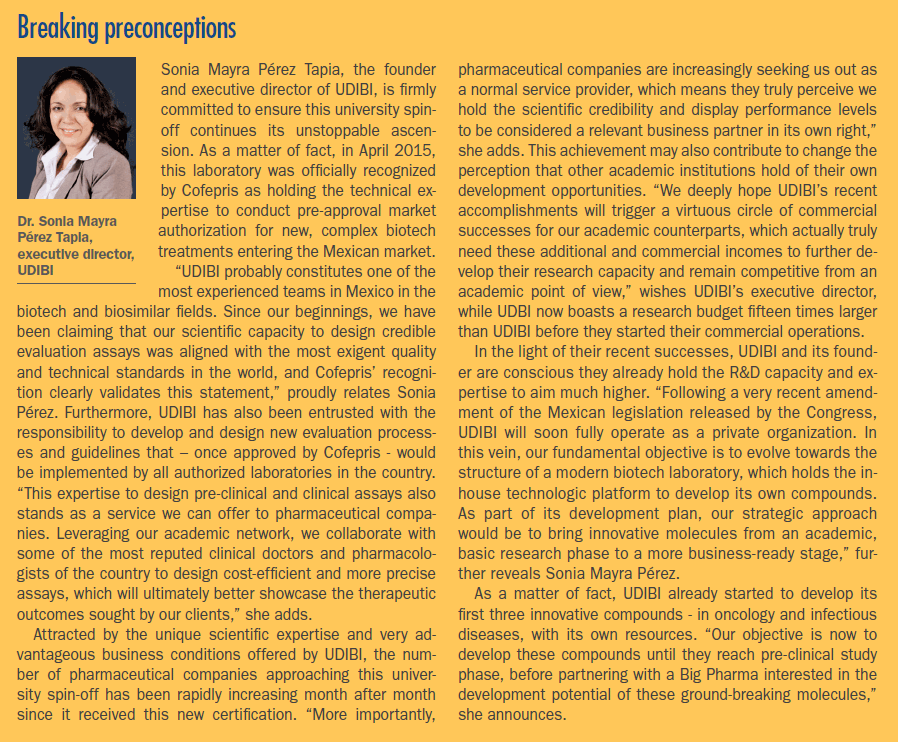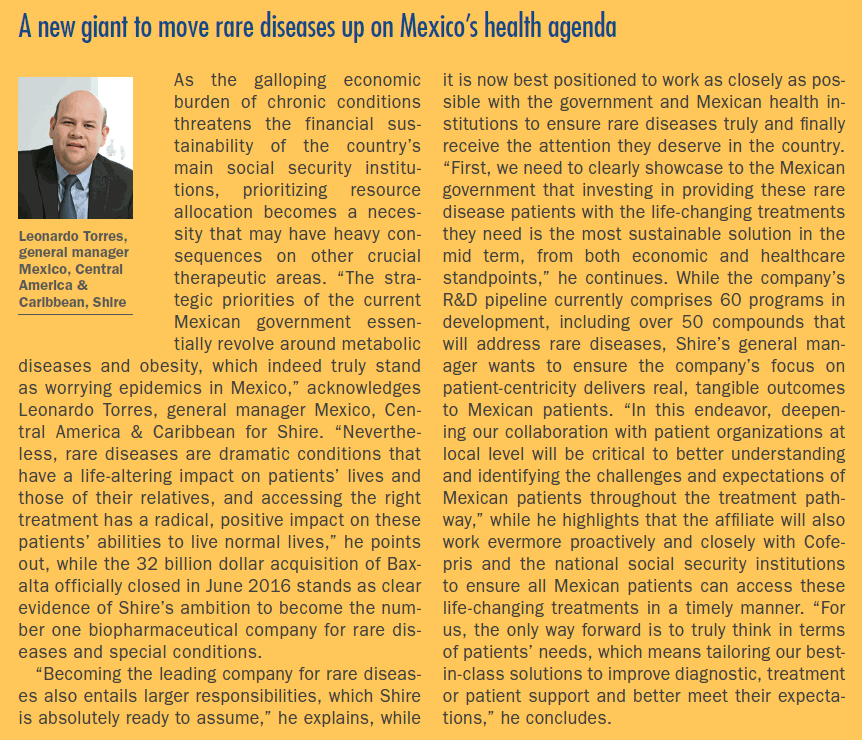Country Report: Mexico
In a regional context marked by chronic instability and turmoil in strategic Latin American economies such as Brazil and Venezuela, Mexico has continually strengthened its positioning as a destination of choice for the global pharmaceutical industry.
This sponsored supplement was produced by Focus Reports
Project Coordinator:Lisa Diericks, Roxane Höck
Editorial Coordinator: Laurent Pichotzki-Libano, Luis Sancho
Graphic Assistance: Miriam Léon
Project Publisher: Mariuca Georgescu
For exclusive interviews and more info, please log onto www.pharmaboardroom.com or write to contact@focusreports.net
Photo credits: Tree of life. Flickr: ~*Bomba Rosa*~
Stepping up the pace
In a regional context marked by chronic instability and turmoil in strategic Latin American economies such as Brazil and Venezuela, Mexico has continually strengthened its positioning as a destination of choice for the global pharmaceutical industry, while the country's GDP growth is expected to strengthen to 3 percent in 2017, according to the OECD. "From economic and demographic standpoints, Mexico continues to boast an excellent and stable macro-economic environment that should draw the attention of any potential investor," highlights Rafael Gual Cosío, general director of CANIFARMA, the Mexican industry chamber that brings together multinational and domestic manufacturers.

Besides being the second most populous country in Latin America with a population of more than 127 million inhabitants, Mexico's most striking specificity is probably the remarkable keenness of both government and regulatory stakeholders to publicly acknowledge the importance of the pharmaceutical industry in terms of health and economic outcomes – to an extent that is currently almost unimaginable in the US or some European countries. "Our country is in the lucky position to hold a strong, thriving private sector [...] and healthcare industries proudly stand as some of the most important sectors of our country's economy," states Dr. José Narro Robles, Secretary of Health of Mexico. "I also deeply believe we can reach even greater health outcomes by better aligning the public and private sectors, which are truly complementary in our country," he continues. In this vein, Mexico's regulatory and sanitary agency, Cofepris, does not hesitate to emphasize the rising trajectory of the industry, to which it has been a key contributor. "The pharmaceutical sector in Mexico has displayed robust and continuous growth in recent years, while the regulatory compliance of the sector has been indisputably improving as well," says Cofepris' new federal commissioner, Julio Sánchez y Tépoz. This collaborative approach goes beyond regulatory and political aspects, and structural support is also high on the agenda of Mexico's key public stakeholders. "We notably want to move forward on developing more healthcare-related clusters across our country, positively impacting advanced manufacturing, clinical research developments and cross-sector innovation," explains Francisco González Díaz, CEO of ProMéxico, the Mexican investment agency.
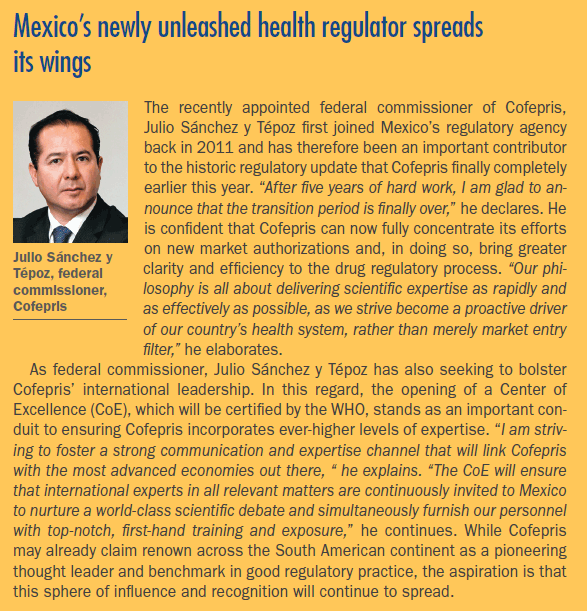
Over the last two years, the pharmaceutical industry has indisputably risen in importance to become a critical sector for Mexico's economy and its population. "We already stand as the third largest manufacturing sector of the country in terms of manufacturing GDP. Furthermore, the growth of our industry's annual production has been continuously outpacing the growth of our country's population, which highlights a strong and enduring domestic demand for our industry's products. In the meantime, pharmaceutical exports are also growing faster than the average growth rate of our country's total exports," documents Alexis Serlin, country president of Novartis and president of CANIFARMA. Serlin expects the pharmaceutical sector to eventually fulfill its long-awaited objective within the upcoming months: being officially recognized as a strategic sector by both the Ministries of Health and Economy.

Dr. José Narro Robles, secretary of health of Mexico
Nevertheless, one should not think that the pharma industry has been consolidating this leadership position on top of an easy-to-navigate market. "The rapidly-evolving Mexican market is an interesting mix between an emerging and a developed market, holding the complexities of both," warns Pedro Galvis, general manager at Merck KGaA, "and you have to be particularly flexible to truly manage the particularities of this market and benefit from its dynamism."

Francisco Salvador López Brito, president of the Senate Health Commission
ROBUST GROWTH, BOUNTIFUL OPPORTUNITY
In Mexico, successful general managers cannot afford to not extremely closely follow the evolution of a market that has already proven to radically change over a six-month time. "We are probably the only Pierre Fabre affiliate in the world that is building its marketing or territory plans by fully leveraging two fundamental elements: the voice of the market (physicians and patients) and our sales teams' insights. We really design our strategic development based on the views gleaned from our teams on the field, while this bottom-up approach objectively is rarely used within the industry," explains Karel J. Fucikovsky, general director Latin America at Pierre Fabre Médicament.

Mikel Arriola, general director, IMSS
According to IMS Health, from 2014 to 2015, the total pharmaceutical market in Mexico displayed a strong 5.3 percent growth to reach 209.5 billion Mexican pesos [USD 11.14 billion]. At the same time, some product categories have been displaying even more impressive growth rates. "The Mexican biotech market – comprising both innovators and biosimilars – has been growing by seven percent CAGR over the last three years to reach a market value of USD 1.123 billion," explains Xavier Valdez, general manager North Latin America of IMS Health, while "the value of the oncology market in Mexico has been growing at a rate of almost eight percent between June 2015 and 2016." Overall, Mexico has been displaying a remarkable consistency in terms of market growth, and analysts expect this growth to continue in the upcoming years. "Mexico is considered the only Latin American country whose market value growth will be higher than what we had in past years. The only parameter that could relatively shade this impressive performance is the recent devaluation of the Mexican peso," Valdez continues.

José Reyes Baeza Terrazas, general director, ISSSTE
Nevertheless, the context that sustains these promising growth rates has changed dramatically from one year to another. "Interestingly, the private retail market grew 7.1 percent over the past 12 months, whereas it had dropped 0.2 percent in 2014," says Valdez. This return to robust growth of the private sector is now propelling the overall market, as the retail market still represents 74 percent of total Mexican sales, while the increasing availability of medical consultations at the pharmacy point of sales is also probably nurturing a relative displacement of the consumption from the institutional to the retail sector. "An important change in the private market was the introduction of added value services such as the development of physicians' offices adjacent to pharmacies, which offer convenience with affordable prices, making them particularly popular with the low and middle-classes for common or acute illnesses", highlights Mario Sturion, general manager of Janssen. "Original brands' growth however didn't exceed two percent in 2015, and generics and pharmacy chains' private labels take the lion's share of the growth of the retail market, by displaying growth rates comprised between fifteen and twenty percent per annum," reveals Alvaro Angel, country division head at Bayer Pharma.

Gabriel J. O'Shea Cuevas, national commissioner, Seguro Popular
More importantly, "the increase of the institutional sector slumped to two percent annually, whereas we reported a nine percent growth in 2014," states Xavier Valdez. What truly draws the attention of all pharma observers is that the disappointing performance of the Mexican institutional market finds its roots in a deeper macro-economic context that is set to remain for the upcoming years.

Rafael Gual Cosío, general director, CANIFARMA
BETWEEN A ROCK AND A HARD PLACE
"As a consequence of a complicated international environment, the Mexican government faces difficulties in maintaining its annual budget year on year, and total budget cuts amounted to ten billion pesos in 2015 and nine billion pesos in 2016," explains Cristóbal Thompson, executive director of AMIIF, the association gathering 43 pharma innovators implanted in Mexico. In a country where total health spending only amounts to 6.2 percent of GDP, one of the lowest rates among all OECD countries, "real health spending's growth has moreover been decreasing by 0.5 percent every year since 2012, while administrative costs have increased by five percent and represents 8.8 percent of total health spending – almost three times the average of the OECD," continues Thompson. Furthermore, "the Ministry of Health is already strongly indebted to several drug manufacturers, at around seven billion Mexican pesos [USD 380 million]," explains Salvador López Brito, the president of the Health Commission of the Senate. In this dramatic context, "AMIIF is working closely with the main public partners related to the health and economic sectors around the necessity to urgently increase public investment in health, especially if we don't want to compromise the economic potential of the country," says Javier Amtmann Aguilar, chairman of the board of Menarini Mexico and president of AMIIF, while the association is currently assembling a strong, evidence-based case to demonstrate how investing in health would spark productivity in Mexico's economy. "I believe that the government and public stakeholders in general need more help, and more participation from both the industry and think tanks, to carry out the studies that are relevant to this assessment," stresses Roberto Martínez Yllescas, general director of the Mexico Center for Latin America of the OECD, which also advocates for smarter and more transparent public health spending in Mexico.

Cristóbal Thompson, executive director, AMIIF
These budget cuts undoubtedly put tremendous pressure on a public health system that moreover has to cope with Mexico's epidemiological transition, while in 2020, the adult population will constitute the majority for the first time in the country's history. "Chronic and non-communicable diseases have further deepened an unequal resources allocation, as 80 percent of our health expenditures are used to treat only 20 percent of the Mexican population, affected by only three main illnesses: diabetes, cancer, and cardio-vascular diseases," explains Mikel Arriola Peñalosa, former head of Cofepris and recently appointed general director of IMSS, the largest social security institution in the country.

Alexis Serlin, country president, Novartis, & president, CANIFARMA
In Mexico, 71 percent of the population is obese or overweight. More importantly, "one out of every three children can be considered as being in a state of obesity, which is a very alarming situation for the future of our country," highlights Enrique Graue Wiechers, president of the National Academy of Medicine and rector of UNAM, the largest and one of the most prestigious universities in Latin America. Diabetes has also truly become a worrying epidemic threatening the lives of 13 million people (14 percent of the total adult population), half of them being still undiagnosed and only a quarter of the total having their disease under control.
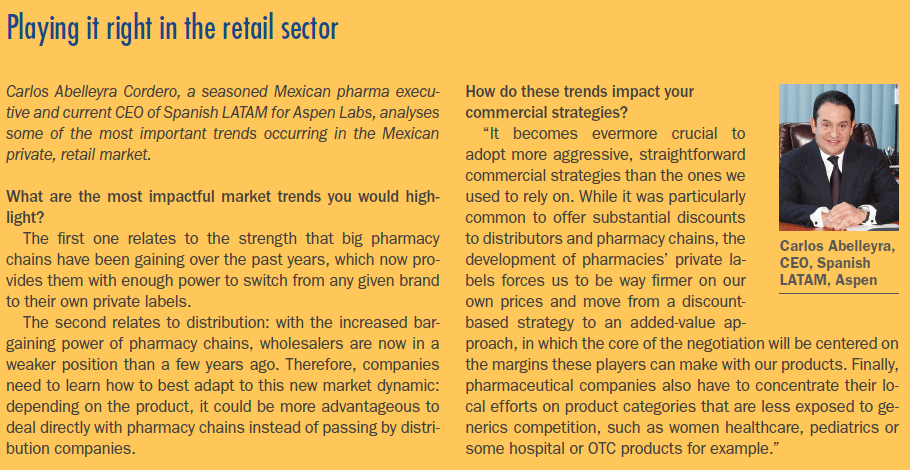
"In Mexico, the diabetes patient population is still growing, while the prevalence of the disease is also further developing - despite the government's efforts to tackle it," relates Morten Vaupel, vice-president and general manager of Novo Nordisk Mexico. "If we are not able to implement game-changing prevention and control measures in the immediate future, health investments to cure chronic diseases will skyrocket from 80 billion Mexican pesos in 2016 [USD 4.3 billion] to 350 billion pesos in 2050 [USD 19 billion], and our health system will never be able to carry such a financial burden," warns Mikel Arriola of IMSSS, which provides medical services to 70 percent of the Mexican population and is deciding to lead the way in chronic disease prevention and management. "In Mexico, the current diagnostic capacity prevents most patients from being properly diagnosed at the symptoms' apparition, which creates a situation where they have to wait for many years and the disease to dramatically degenerate before receiving a correct diagnostic," explains Juan Antonio Sánchez Baca, general manager of UCB Mexico.

Xavier Valdez, general manager North Latin America, IMS Health
As a result, the government's priority is clearly "to strengthen Mexico's prevention, diagnostic and treatment capacity, especially for chronic, non-communicable diseases, while generating better efficiencies within the overall health system," says Secretary of Health Narro. In this regard, 2016 is set to mark the beginning of an ambitious reform that will implement exchange of medical services between the different social security institutions that make up Mexico's public health system, namely IMSS (70 million beneficiaries, essentially workers of the private sector), ISSSTE (covering 13 million workers of the public sector) and Seguro Popular, the financial scheme created in 2004 to provide health services to the 55 million Mexicans without formal employment. "The exchange of medical services will first generate significant improvement in terms of patient outcomes, while also engendering substantial savings for the different social security institutions and tremendously optimize their resource allocation," continues Dr. Narro.
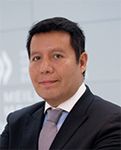
Roberto Martinez Yllescas, general director, Mexico Center for Latin America, OECD
In such a fragmented public system, building bridges between social security institutions whose human and financial resources and processes significantly vary from one to another is easier said than done. "We have to find a consensus on the cost of each and every medical intervention among the different institutions, while also fostering knowledge transfer with regards to patient referral, billing, and payment collections," confirms Gabriel J. O'Shea Cuevas, national commissioner of Seguro Popular, while an initial package of 700 medical services is currently under evaluation as part of the first stage of this reform. "In the long term, we would like to ensure that our beneficiaries can receive any kind of medical services in any hospital or health facility of the country, even if they belong to another social security institutions," plans José Reyes Baeza Terrazas, general director of ISSSTE. In the meantime, the overarching objective of this reform would be to further expand this collaborative approach to other public health areas and notably include infrastructure development. "When considering the construction of a new hospital or high-specialty health center, it should no longer be approached from the perspective of a single social security institution, but with a comprehensive, systemic development vision," explains Dr. Narro.

Javier Amtmann, chairman of the board, Menarini Mexico
In this quest for greater cost-efficiency, medicine purchasing is not obviously left aside, and institutions look at further leveraging the heightened bargaining power offered by consolidated and integrated medicine purchasing schemes among all institutions and throughout the country. "Over the last three years, the latter have already allowed the overall Mexican public health system to save more than 11 billion pesos [around USD 560 million]," explains ISSSTE's Baeza, while this institution also looks at enhancing medicine management and monitoring. Although these ambitious reforms could bring substantial savings and unify a health system scattered between a variety of public payers, innovators still have to navigate a fragmented public system under unprecedented financial pressure.

Enrique Graue Wiechers, president, National Academy of Medicine, and rector of UNAM
THE MULTI-HEADED HYDRA OF MEXICAN MARKET ACCESS
Over last three years, "Cofepris has been able to align its registration timelines with the best international standards, as market approvals are now granted within 60 working days," recalls Julio Sánchez y Tépoz, federal commissioner of Cofepris, whose improvements have been lavishly praised by the industry. As a result, it is no longer rare to see Mexican patients being among the very first in the world to access an innovative therapy. "Mexico was the first country in the world to give a new indication in acute myeloid leukemia (AML) to our treatment previously approved for a rare blood cancer called myelodysplastic syndrome (MDS), and also the first country in the world to grant a new myeloma indication for our multiple myeloma (MM) treatment, the second most commonly diagnosed blood cancer," relates Irma Egoavil, former general manager of Celgene. Furthermore, treatments developed in Mexico can now receive fast-track approval from Cofepris, whose timeline is so short that Mexico can potentially be the first country in the world to approve a given molecule, as occurred in 2014 for Ryzodeg®, one of Novo Nordisk's most innovative diabetes treatments ever.
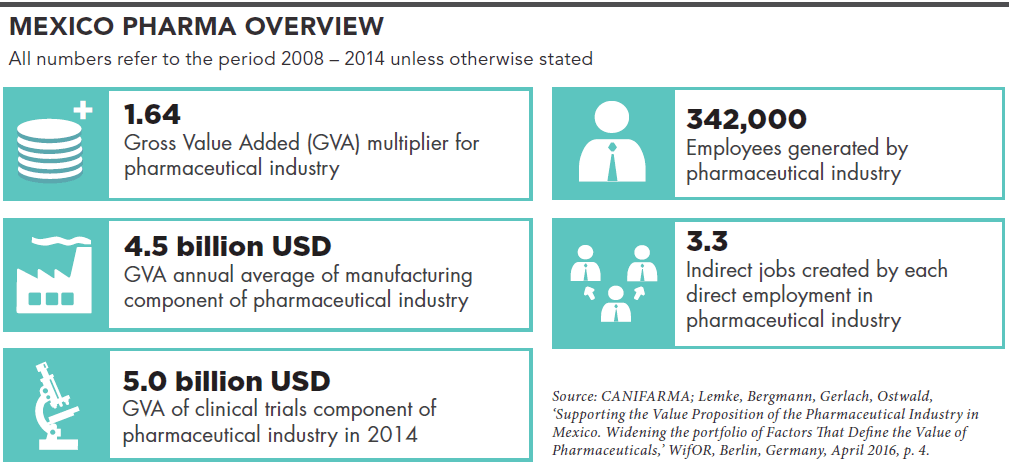
If Cofepris' improvements are incontestable, they however didn't prevent from moving the innovation deadlock from the first stage of the market access process to a later one. Although the private market may be growing faster than the institutional one, only ten percent of the Mexican population can access treatments through the private retail segment. Furthermore, most of the multinationals are now strategically focused on high-cost specialty treatments, which in Mexico are mostly related to the institutional market. "The private insurance system remains particularly underdeveloped in the country, both in terms of population coverage (only six percent) but also with regards to the health coverage/price ratio," regrets Mario Sturion, general manager of Janssen.

Raúl Vivar, general manager, Eisai
"For all innovative companies implanted in Mexico, public market access is the name of the game. So far, Eisai's three Cofepris-approved oncology treatments are only accessible through the private, retail segment and we are now concentrating our efforts on bringing these treatments to the Mexican patients in the public healthcare system," explains Raúl Vivar, general manager of Eisai. Nevertheless, new inclusions into the public sector are currently limited due the budget constraints faced by the public health system, and a substantial number of treatments approved by Cofepris and the General health Council, which assesses whether a treatment should be reimbursed by the public system or not, still wait to be included in the public sector's registries. As matter of fact, "only 15 of the 213 molecules approved by Cofepris over the last three years are now approved for use by the social security," points out Cristóbal Thompson, AMIIF's executive director.

Alvaro Angel, country division head pharmaceuticals, Bayer
Nevertheless, Mexico's public stakeholders maintain cordial relations with drug developers. "Pharmaceutical innovators implanted in Mexico need to understand and acknowledge that IMSS is facing a tremendous necessity to reduce its health expenditures. Nevertheless, we value innovation, and will also take into consideration the savings that new treatments can generate, notably by reducing palliative care expenditures and dependence on the hospital sector," states IMSS' Arriola. "Adopting a cost-benefit evaluation process, our fundamental objective remains to increase the number of diseases covered by our catastrophic disease fund year after year," adds O'Shea of Seguro Popular, whose resources have however been severely impacted by the recent budget cuts.

Irma Egoavil, former general manager, Celgene
This positive attitude of public authorities logically opens the door to the implementation of innovative market access models, which aim at moving forward innovation access in the public sector despite the scarcity of public resources. "Nevertheless, in Mexico, a "one-size-fits-all" approach is doomed to fail: we need to develop customized access strategies for all our therapies, and above all for all the different social security institutions that constitute the Mexican public health system," highlights Rodrigo Puga, the recently appointed general manager of Pfizer Mexico. Where in most countries, pharma innovators already struggle to conceive the best way to bring their new products to patients of the public sector, in Mexico, this effort has to be repeated and adapted to the specificities and expectations of all public payers, which include the three main social security institutions IMSS, ISSSTE, and Seguro Popular but also some smaller, decentralized institutions for PEMEX's employees (the Mexican state-owned petroleum company) or the Mexican Army. "We cannot content ourselves with simply offering what our industry has coined as "differentiated access models" and approach Mexico's public system as a monolithic block, adds Janssen's Mario Sturion. "If we don't concentrate our efforts on identifying the real expectations of Mexico's healthcare institutions, a market access proposal that we may consider utterly innovative or cost saving could ultimately show itself to be inadequate," he continues, while this costly and time-consuming degree of customization renders evermore challenging for companies to solve the cost-efficiency equation that is now at the core of the Mexican conundrum. "The process rigidity of Mexico's multiple social security institutions slows down the implementation of risk-sharing and pay for performance models – although public institutions' leaders are clearly interested in developing such models," explains UCB's Juan Antonio Sánchez.

Rodrigo Puga, president & general manager, Pfizer
This cost-containment pressure combined with the fragmentation of the Mexican system then force innovators to enhance their market approach strategy in a very comprehensive way. "This includes finding strategic alliances with other pharmaceutical companies, becoming more integrated within the top management of the country's main pharma associations, and work more closely than ever with the public and regulatory partners of Mexico," adds Pierre Fabre's Karel Fucikovsky. In this context of scarcity of public resources, it also becomes critical for innovators to ensure their products and their added value ultimately and truly receive the attention they deserve. "In terms of promotion, most physicians of the private sector also hold responsibilities in the public field. As a result, it is absolutely paramount we manage to further consolidate and strengthen our reputation among these physicians," explains Eisai's Raúl Vivar. "We have established 14 extensive partnerships with key research institutions to establish centers of excellence, in which we design the best guidelines possible to fully leverage the scientific-based added value of our treatments by generating local, real-world evidence to document the accurate healthcare improvements that our treatments can bring," details Novartis' Alexis Serlin.

Karel Fucikovsky, general director Latin America, Pierre Fabre Médicament
Beside the recent lack of new product registrations occurring in the public sector, "we see the social security institutes' spending for already registered, high-cost medicines has nonetheless been significantly growing over the past years," points out IMS Health's Xavier Valdez. "When it comes to new biotech treatments targeting unmet medical needs, there is no margin-related debate," acknowledges IMSS' Mikel Arriola. In this context, we understand that if Mexico is considered a strategic market by most international companies of the industry, it is essentially for the enormous, untapped growth potential it holds, at the moment when Big Pharma and Mexican social security institutions' priorities seem to finally meet on chronic, non-communicable diseases. "IMSS has been championing this new, innovative market access approach, and under the leadership of Mikel Arriola, the former head of Cofepris, we can hope the public and private sectors could soon jointly find ways to overcome our institutions' rigidity and increase our patients' access to innovative treatments, in a sustainable way," adds UCB's Juan Antonio Sánchez.

Juan Antonio Sánchez Baca, managing director, UCB
Nevertheless, for off-patent treatments, further opening the door to therapeutic alternatives will remain the priority of the institutional sector, which already massively shifted its focus to generics a few years ago. "Generics will continue to play a tremendous role in providing our beneficiaries with affordable and well-supplied access to medicines," highlights Mikel Arriola.

Morten Vaupel, vice president & general manager, Novo Nordisk
GENERICS: GENERATING VALUE AT THE CORE
"In Mexico, regulators have actively and continuously been enhancing the penetration of generics. Over the past three years, Cofepris has been implementing fast-track market access measures to allow generics companies to bring their products to the market more swiftly, and these regulatory improvements are clearly paying off," says Mariano de Elizalde, general manager of Sandoz. With the registration of 491 new generics related to 47 different molecules over the last five years, Cofepris has been then able to generate total savings of more than USD 25 billion, while the average medicine cost decreased by 61 percent. In the meantime, generics have been displaying the highest growth rates in the retail sector and overall account for around 79 percent of the total units sold in the country (retail and institutional markets comprised) according to IMS Health, establishing Mexico as, de facto, one of the most mature generics markets in the world.

Pedro Galvis, general manager, Merck
In 2010, Cofepris decided to fully open the door to international companies, and local manufacturing was no longer required to sell treatments in Mexico. "As a result, many international competitors have been entering the generics market over the last six years, notably from China and India, while generous timelines were given to them to comply with Cofepris' increasing requirements, which allowed them to be even more cost competitive until they ultimately fulfil this compliance effort," explain the general directors of Rayere, an historical Mexican company with more than 50 years of activity in the country. "In the meantime, some Mexican manufacturers have been increasing their manufacturing capacities, in order to compete with the large-volume approach brought by these international newcomers," they add.

Mariano de Elizalde, general manager, Sandoz
The Mexican company Loeffler is also now following this trend in order to cope with both the continuous expansion of the Mexican generics market and the company's ambition to maintain the width of its portfolio, which proudly stands as one of largest in the market. "For example, one of our main products started selling at a rate of 70,000 units, while now it has sales above the 300,000-unit mark. If we don't upgrade our manufacturing capacity, we won't be able to fully leverage the growth potential of the Mexican market," explains José Angel García Hinojosa, counsellor of the board of Grupo Loeffler Russek.

José Angel Garcia, counsellor, Grupo Russek Loeffler
These once-relatively-small, pioneering, and usually privately-owned Mexican generics companies have been particularly successful over the last decade and now stand as the fastest-growing players in the Mexican market, according to the IMS data. "Alongside their expansion, local companies have accumulated a huge amount of experience and are embracing more organized corporate structure and development strategy. Loeffler's philosophy for example is to approach the improvement opportunities we identify from every angle possible, by transforming our organization as a whole. This holistic strategy stands as the most successful manner to remain as cost-efficient, lean, and integrated as possible – without compromising our ambitious growth objectives," explains Loeffler's José Angel García Hinojosa. "I expect the eye-catching successes of domestic companies to increasingly draw the attention of international players, and we can expect new international partnerships and significant acquisitions to happen in the upcoming years," he continues.
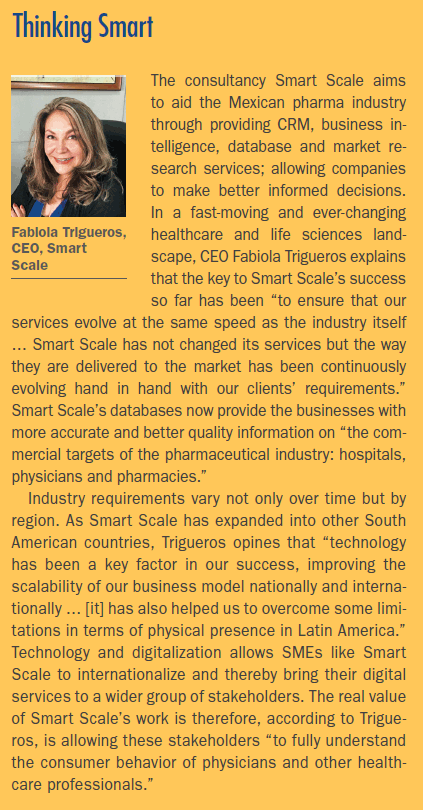
Despite it is becoming increasingly competitive, the Mexican generics market indeed still holds a very interesting depth – as long as you know where to look. "While most local pharmaceutical manufacturers used to hold large product portfolios, Mexico's heightened regulatory framework has forced most of these companies to become more specialized and to focus on only a certain number of therapeutic areas. This dynamic has created huge opportunities for us: as the industry is becoming ever more specialized, some market areas are now underserved, while these market needs have not vanished overnight," according to Juan José Aguirre Salazar, commercial director of Grupo Bruluart, one of the foremost healthcare companies in Mexico. In this regard, Bruluart now holds a complete product portfolio for metabolic diseases, "while we are expanding our footprint in the hormonal and birth control areas, in which many important patents have recently expired or are about to expire, while market needs in these fields are rapidly growing and still largely unmet in Mexico." In the meantime, the price war occurring in the public sector means that appealing margins coming from increasingly consolidated public tenders are difficult to foresee over the upcoming years, and many domestic generics companies are increasingly focusing their efforts on the thriving - but highly competitive - retail generics market.

Andrés Aguirre Salazar, strategy director, Grupo Bruluart
As pharmacies exclusively selling generics are flourishing across the country, Mexican patients and consumers have been developing a remarkable brand sensibility to branded generics. "Some of our products are now marketed as classic branded products and not as generics anymore," documents Juan José Aguirre Salazar of Bruluart. This market specificity notably provides some manufacturers with a heightened bargaining power towards thriving and consolidating big pharmacy chains, whose private labels are gaining market share year after year.

Juan José Aguirre Salazar, commercial director, Grupo Bruluart
"As physicians explicitly prescribe some of our branded generics products and patients also attend a given pharmacy to specifically purchase them, big pharmacy chains cannot afford not to offer these treatments. This strategic asset allows us to introduce a mixed portfolio into these strategic pharmacy chains, including both our strong brands and the rest of our portfolio," continues Andrés G. Aguirre Salazar, strategy director of Grupo Bruluart. This also means that the strategy of these companies have been evolving accordingly, and product development capacity has gained an importance as substantial as the quality of their manufacturing capacity. "Bruluart is no longer a generics company solely focused on the cost-competitiveness of its products, and we are considering many exciting growth options for our pharma branch, including new patented products and new presentations of our best sellers," concludes his brother Juan José Aguirre Salazar.
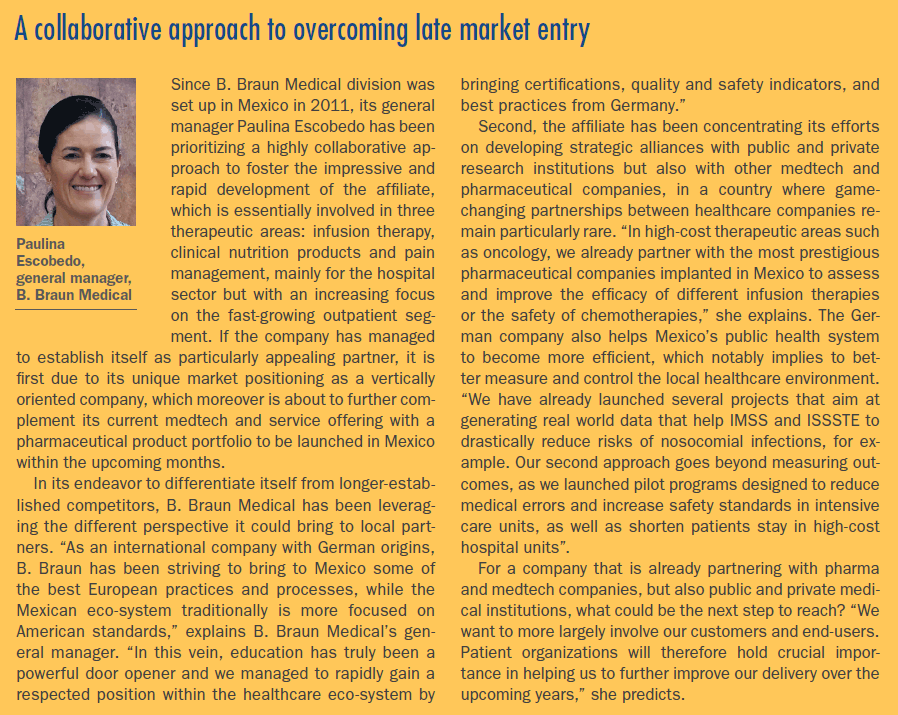
As Mexico already stands as the most sophisticated generics market in the region, some of these companies do not want to limit this product development expertise to the boundaries of the Mexican market. "We have already started to work with legal partners to register our patents in other markets including the US and Europe, and we are looking for business partners, including international pharmaceutical companies, that could help us in bringing and distributing these products in and to new countries," explain Rayere's general directors.
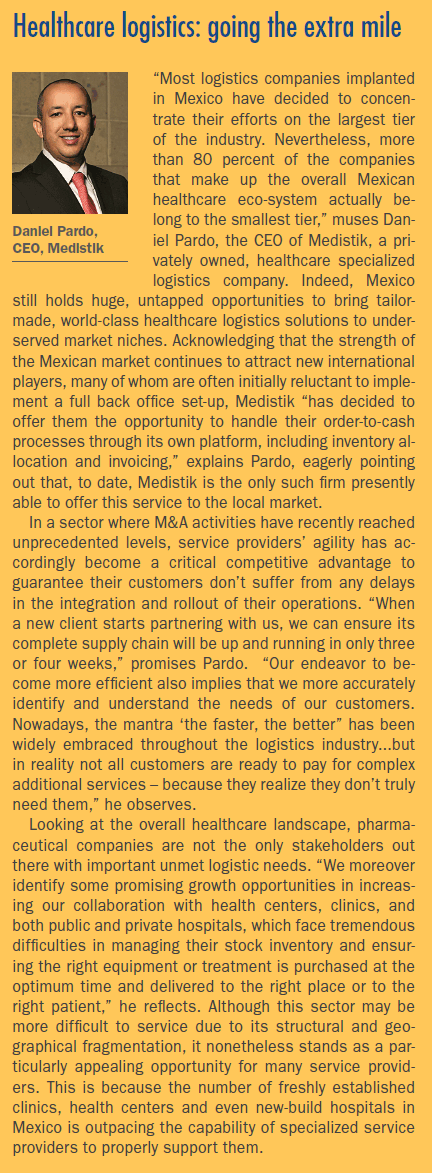
In this regard, the improving competitiveness of the Mexican pharmaceutical manufacturing eco-system combined with its increasingly recognised quality standards and expertise will play a fundamental role in nurturing the local and international ambitions of domestic pharmaceutical manufacturers.

SUPPORTING A THRIVING HECHO EN MEXICO
Cofepris' recent entry into the Pharmaceutical Inspection Convention Scheme (PIC/S), alongside 49 other international regulatory agencies, undoubtedly stands as a historical milestone that will further help Mexican manufacturers broaden their market perspectives and export their products all over the world. "The pharmaceutical industry implanted in Mexico can expect a tremendous decrease in inspection costs, as complying with any PIC/S country's inspection will be simultaneously recognized by all other members," reveals Julio Sánchez y Tépoz, Coferpris' federal commissioner. This new international certification comes together with Cofepris' recognition as a National Regulatory Authority of Regional Reference by the Pan-American Health Organization (PAHO) and as Functional Regulatory Agency for vaccines by the World Health Organization (WHO).

Socorro España Lomelí, executive director, ANAFAM
Looking at the most promising export destinations, the industry nurtures high hopes regarding all the countries that recently signed the Trans-Pacific Partnership (TPP), as well as those that have bounded regulatory agreements with COFEPRIS, like Australia, Japan, and Canada. In the meantime, Mexico is currently negotiating Free-Trade Agreements (FTAs) with Turkey and Jordan, while "some Asian and African countries are particularly interested in Mexico's expertise in infectious diseases," highlights Francisco González Díaz, CEO of ProMéxico.

Hetero Research Foundation, Courtesy of Hetero
"Our top priority will however remain the US market. In this regard, we need COFEPRIS to finally be recognized by the FDA as a sanitary authority implementing stringent-enough regulations and controls, so Mexican manufacturers will ultimately be able to massively export their production to the United States, and no longer proceed by single isolated units," explains Socorro España Lomelí, the executive director of Mexico's National Association of Drug Manufacturers (ANAFAM). Conscious of the remaining steps that could help Mexico to establish itself as an incontestable pharma manufacturing hub, the association has also been intensifying its efforts towards the Ministry of Economy to ease pharma exports, reimbursements, or reduce IRS auditing. Many voices among the domestic industry highlight the fact that Mexico still lacks a comprehensive, integrated industrial policy which would help these ambitious companies create and showcase the value needed to seize international opportunities. "In Mexico, public authorities' support gets scarcer as soon as companies start implementing international strategies and no longer solely concentrate their efforts on the Mexican market," highlights Efrén Ocampo, CEO of Mexican group Neolpharma.

Mario Sturion, general manager, Janssen
Another important frailty of the Mexican manufacturing ecosystem relates to the fact that 92 percent of the total APIs used in Mexico are imported, a situation that is becoming evermore critical considering the recent depreciation of the Mexican peso, while APIs can amount to up to 80 percent of the production cost of a pill. "In 2015, for each dollar of pharmaceutical products we export, we import five dollars in return – and this deficit is largely attributable to API imports," details ANAFAM's España Lomelí. Improving the local manufacturing of APIs will however imply rekindling Mexico's national chemical industry, which almost vanished with the implementation of the North American Free Trade Agreement (NAFTA) in 1994. "Another main challenge we face will be to make the local production of APIs more cost-effective than imports from China or India, which won't be an easy task considering the initial investments needed to trigger the dawn of local API manufacturers," she continues. This analysis echoes the strategic approach for the Mexican market that has been following Hetero, one of the leading manufacturers of APIs in the world. "Our API manufacturing footprint is uniquely concentrated in India, where we notably hold one of the biggest API plants in the world, covering more than 500 hectares, 1000 API manufacturing reactors and employ around 6000 people," details Gurulinga Konanur, general manager of Hetero. "The impressive size of this cutting-edge facility helps us to be extremely competitive, even in comparison to our Chinese competitors. By relocating a part of our manufacturing capacity to Mexico, we will then lose the cost-efficiency that the size of this manufacturing facility offers," he adds.

Efrén Ocampo, CEO, Neolpharma
If the areas for improvement needed to step up the pace of Mexican pharmaceutical manufacturing have been identified and are awaiting positive developments, the tireless efforts of Mexico's public stakeholders to attract and ease healthcare investments are already paying off. "In Mexico, new market entrants can expect to receive extremely valuable support from public and regulatory authorities," continues Gurulinga Konanur. "In comparison to other parts of the world, setting up a healthcare business in general and a manufacturing facility in particular are not so difficult, as key stakeholders really strive to ramp up newcomers' maturation phase to help them become operational as soon as possible," he concludes.

Francisco González, CEO, ProMéxico

Neolpharma Manufacturing Facilities, Courtesy of Neolpharma
